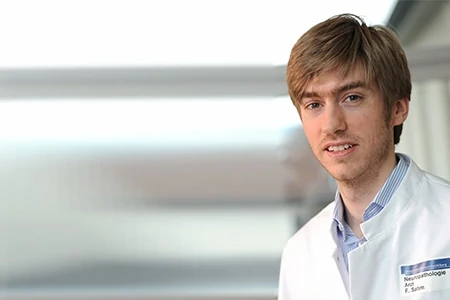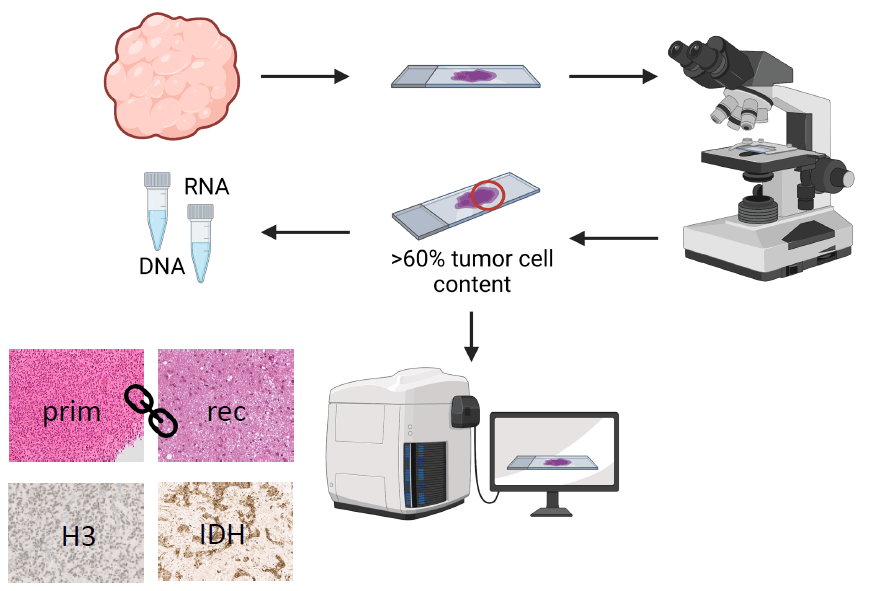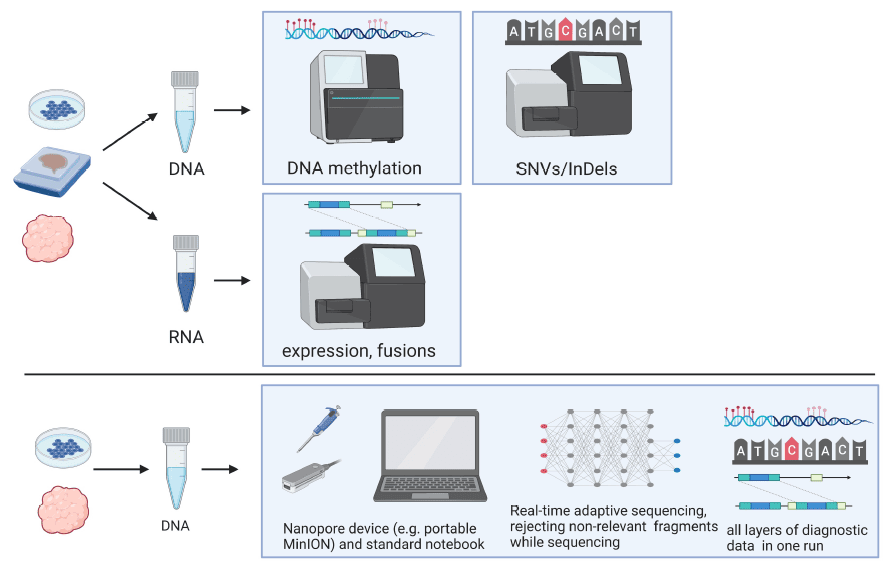Research > Focus D > Work Packages D01
Summary
This central project aims at ensuring uniform availability and quality of tissue material and high-throughput data in cost-effective and state-of-technology way to be used in UNITE subprojects (coined UNITE Core Collection). Our aim is to work with and provide material and data from newly diagnosed patients and matching recurrences, which has been stringently standardized, characterized and analyzed reflecting the multilevel approach of UNITE.
Task 1
Biobanking at neurosurgery in Heidelberg and Mannheim
Steps / Workflow
- Inspection for tumor cell content at NPATH HD
- Digitalization of slides in NPATH HD
- Focus on matched recurrent Glioblastoma IDH-wt, H3-altered glioma and Astrocytoma IDH-mut grade 4
Task 2
Molecular characterization of tumors and primary cell cultures
Steps / Workflow
Profiling for
- DNA methylation (850k)
- CNVs (850k, lcWGS)
- SNVs/InDels (panel, WES, WGS)
- Rearrangements (RNA, lcWGS) Expression (RNA)
Application of RAPID-CNS2 (A06) (Patel ANP 2022)
- DNA methylation
- CNVs, SNVs/InDels
- Rearrangements
Task 3
Spatial sequencing
Steps / Workflow
- Established platforms (10x Visium, CytAssist)
- Expanding by novel, highresolution Xenium
- Assist in panel generation and devise a comprehensive UNITE panel for targeted (Xenium) analysis
- Develop algorithm for cell segmentation (with C04, D02, A06)

Ratliff, Miriam, Dr.med., Dipl.-Biol.
University Medical Centre Mannheim, Medical Faculty Mannheim, Heidelberg University Theodor-Kutzer-Ufer 1-3, 68167 Mannheim

HEROLD-MENDE, CHRISTEL, PROF. DR. RER. NAT.
University Hospital Heidelberg, Department of Neurosurgery, Division of Neurosurgical Research, Im Neuenheimer Feld 400, 69120 Heidelberg, Germany

SAHM, FELIX, PROF. DR. DR. MED.
University Hospital Heidelberg, Department of Neuropathology, Im Neuenheimer Feld 224, 69120 Heidelberg, Germany
Address
Im Neuenheimer Feld 400
69120 Heidelberg
Themen
Research
- Focus A
- A01: Targeting tumor cell network communication to overcome primary and adaptive resistance in glioblastoma
- A02: Development of a specific combination therapy for histone H3-mutant pediatric glioblastoma
- A03: Deciphering resistance against targeted treatments
- A04: Elucidating tumor-associated microglia interactions in astrocytomas CNS WHO-grade 4
- A05: Predictive biomarkers for MGMT-promoter-methylated glioblastoma (2019 – 2023)
- A06: Resistance mechanisms of glioblastoma against alkylating agents and radiotherapy
- A07: Mapping and targeting neuron-tumor networks to tackle therapy resistance in glioblastoma
- A08: Personalized glioblastoma treatment guided by patient-derived tumor organoids
Research
- Focus B
- B01: Mechanisms of response and resistance to glioma-specific t cells
- B02: DNA mis-match repair regulates immune checkpoint blockade therapy in glioblastoma (2019 – 2023)
- B03: Targeting immunosuppressive programs in isocitrate dehydrogenase mutant gliomas
- B04: Impact of myeloid cells on the adaptive immune response in newly diagnosed and recurrent glioblastomas
- B05: Dissecting the response of glioblastoma and its tumor microenvironment to focused high-dose radiotherapy (2019 – 2023)
- B06: Visualization and characterization of immune responses in H3K27M mutant gliomas
Research
- Focus C
- C01: Comprehensive preclinical pharmacology testing of drugs used for glioblastoma treatment
- C02: Radiomics, radiogenomics and deep-learning in neurooncology
- C03: Imaging immune signatures of glioma response and resistance towards immunotherapy (2019 – 2023)
- C04: Metabolic signaling in glioblastoma: a spatial multi-omics approach
- C05: Overcoming glioma radio-resistance with particle therapy
- C06: Functional characterization of EGFR structural variants associated with long-term survival in glioblastoma, IDH-WT




